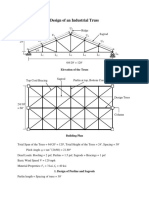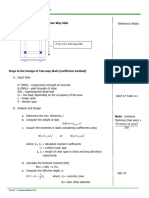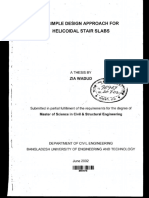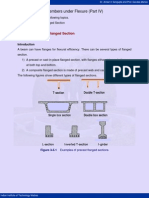0 ratings0% found this document useful (0 votes)
67 viewsGeneral Principles of Bridge Design
The document discusses general principles of bridge design and seismic design. It notes that bridges are structurally simple but sensitive structures that require proper detailing of piers to allow for ductile behavior during seismic events. Design should also check for displacements of bearings and joints, potential ground failures, and liquefaction or landslides that could impact the structure. Elasto-plastic design is commonly used, allowing plastic hinges only in piers to remain elastic, though plastic hinges should form simultaneously when possible in accessible locations without brittle failures or large axial forces. Relevant codes for seismic bridge design from Eurocode 8 and Greek guidelines are also cited.
Uploaded by
Jason GuzmanCopyright
© © All Rights Reserved
Available Formats
Download as DOCX, PDF, TXT or read online on Scribd
0 ratings0% found this document useful (0 votes)
67 viewsGeneral Principles of Bridge Design
The document discusses general principles of bridge design and seismic design. It notes that bridges are structurally simple but sensitive structures that require proper detailing of piers to allow for ductile behavior during seismic events. Design should also check for displacements of bearings and joints, potential ground failures, and liquefaction or landslides that could impact the structure. Elasto-plastic design is commonly used, allowing plastic hinges only in piers to remain elastic, though plastic hinges should form simultaneously when possible in accessible locations without brittle failures or large axial forces. Relevant codes for seismic bridge design from Eurocode 8 and Greek guidelines are also cited.
Uploaded by
Jason GuzmanCopyright
© © All Rights Reserved
Available Formats
Download as DOCX, PDF, TXT or read online on Scribd
You are on page 1/ 3
General principles of bridge design
In general, bridges are simple structures from the structural point
of view. However, they are also sensitive structures.
Beyond the seismic analysis, the design of bridges must also
include:
Proper detailing for ductile behaviour of the piers even if elastic
analysis is performed)
Check of displacements (bearings, joints, sitting areas)
Check of ground failure (foundation of piers, infills behind the
abutments)
Check of liquefaction potential or land-sliding in the wider area that
might affect the structure
Seismic design
Elasto-plastic design is performed (in general).
Plastic hinges are allowed only in the piers. The bridge deck shall
remain within the elastic range.
Flexural hinges need not necessarily form in all piers. However the
optimum behaviour is achieved if plastic hinges develop
approximately simultaneously in as many piers as possible.
As far as possible the location of plastic hinges should be selected
at points accessible for inspection and repair.
Brittle modes of failure (e.g. shear failure) are not allowed.
Plastic hinges shall not be formed in reinforced concrete sections
where the normalized axial force is large.
Codes
Eurocode 8: Design of structures for earthquake resistance Part
2: Bridges.
Greek
Guidelines for the seismic design of bridges, Circular 39/99
(//884/24.12.1999 .....).
Guidelines for the seismic isolation of bridges, .....
Download from:
http://www.iabse.gr/en/en_EngineeringIssues/en_Standards.htm
You might also like
- Analysis and Design of Flat Slab by Using Etabs Software: 1.1 GeneralNo ratings yetAnalysis and Design of Flat Slab by Using Etabs Software: 1.1 General8 pages
- Nicholson - Simple Bridge Design Using Prestressed BeamsNo ratings yetNicholson - Simple Bridge Design Using Prestressed Beams99 pages
- Earthquake Engineering: Engr. Rolando A. Bitagun JRNo ratings yetEarthquake Engineering: Engr. Rolando A. Bitagun JR28 pages
- 5 Storey Mixed Office Residential Using Midas Gen STATICNo ratings yet5 Storey Mixed Office Residential Using Midas Gen STATIC132 pages
- Static Seismic Analysis For Structures in Libya Using Equivalent Lateral Force (ELF) in (IBC-2009)No ratings yetStatic Seismic Analysis For Structures in Libya Using Equivalent Lateral Force (ELF) in (IBC-2009)6 pages
- Structural Design Checklist Based On NSCP 2015 and Its Significance To Construction PracticeNo ratings yetStructural Design Checklist Based On NSCP 2015 and Its Significance To Construction Practice69 pages
- Connections Example For RC-RE: 1) Retrieve The StructureNo ratings yetConnections Example For RC-RE: 1) Retrieve The Structure30 pages
- CE 437 - PDF 01 - Intro 01 - Steel - (Design of Steel Structure)No ratings yetCE 437 - PDF 01 - Intro 01 - Steel - (Design of Steel Structure)13 pages
- Dynamic Analysis of Irregular StructuresNo ratings yetDynamic Analysis of Irregular Structures43 pages
- 16th ASEP International Convetion - Presentation Paper - JOSE SY - 2No ratings yet16th ASEP International Convetion - Presentation Paper - JOSE SY - 29 pages
- Structural Report - Sagar Meher Shrestha PDFNo ratings yetStructural Report - Sagar Meher Shrestha PDF45 pages
- Working With The Database Management SystemNo ratings yetWorking With The Database Management System15 pages
- European Design Guide For Footbridge VibNo ratings yetEuropean Design Guide For Footbridge Vib88 pages
- Peikko Group Product Catalog 2015-02-02No ratings yetPeikko Group Product Catalog 2015-02-02124 pages
- ETABS 2016 Steel Frame Design: ETABS 2016 16.2.1 License # 1SRAL4HSLYXM7Q8No ratings yetETABS 2016 Steel Frame Design: ETABS 2016 16.2.1 License # 1SRAL4HSLYXM7Q83 pages
- Step by Step Procedure of Input Value in Etabs Notes 1No ratings yetStep by Step Procedure of Input Value in Etabs Notes 17 pages
- Presentación Diseño Por Desempeño - Es.enNo ratings yetPresentación Diseño Por Desempeño - Es.en65 pages
- CE 370-Lecture-7 (Flexural Behavior of RC Beams - Ultimate Stage) (Read-Only) PDFNo ratings yetCE 370-Lecture-7 (Flexural Behavior of RC Beams - Ultimate Stage) (Read-Only) PDF24 pages
- Specialized 413a - Course-Syllabus-OBE-CDIO-Format-2022No ratings yetSpecialized 413a - Course-Syllabus-OBE-CDIO-Format-20228 pages
- Seismic Evaluation of Reinforced Concrete StructuresNo ratings yetSeismic Evaluation of Reinforced Concrete Structures28 pages
- A Catalogue of Details on Pre-Contract Schedules: Surgical Eye Centre of Excellence - KathFrom EverandA Catalogue of Details on Pre-Contract Schedules: Surgical Eye Centre of Excellence - KathNo ratings yet
- Structural Engineering DocumentsFrom EverandStructural Engineering DocumentsJorge de BritoNo ratings yet
- Hyperbolic Structures: Shukhov's Lattice Towers - Forerunners of Modern Lightweight ConstructionFrom EverandHyperbolic Structures: Shukhov's Lattice Towers - Forerunners of Modern Lightweight ConstructionNo ratings yet
- Numerical Methods and Implementation in Geotechnical Engineering – Part 1From EverandNumerical Methods and Implementation in Geotechnical Engineering – Part 1No ratings yet
- Seismic Design of Bridges: Bridge TypesNo ratings yetSeismic Design of Bridges: Bridge Types16 pages
- Introduction To Modeling and Analysis of Structures100% (1)Introduction To Modeling and Analysis of Structures65 pages
- CODES Consultants, Inc.: Design of Column (C2)No ratings yetCODES Consultants, Inc.: Design of Column (C2)1 page
- CODES Consultants, Inc.: Design of Column (C2)No ratings yetCODES Consultants, Inc.: Design of Column (C2)1 page
- Drainage Design and Analysis Using The Rational Method: Hands-On Training 9 February 2011No ratings yetDrainage Design and Analysis Using The Rational Method: Hands-On Training 9 February 201120 pages








































































